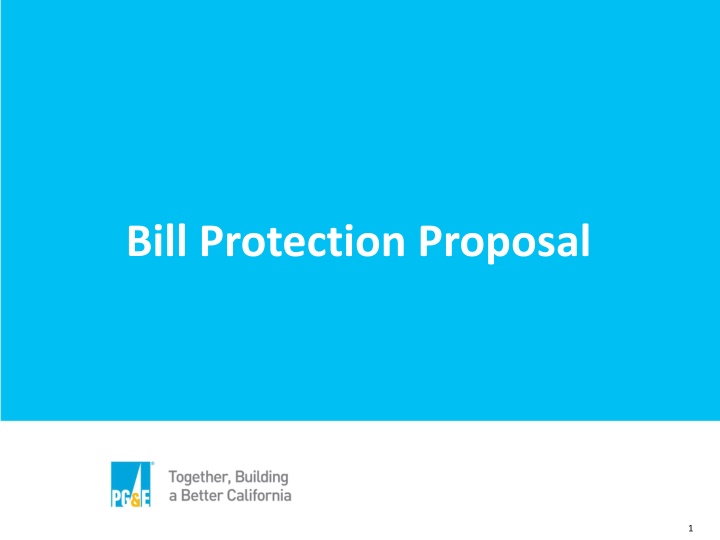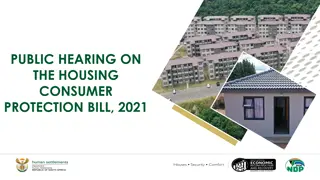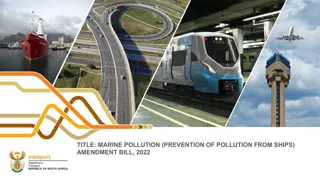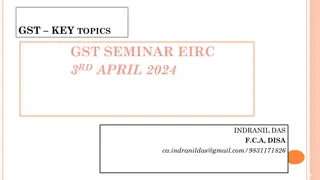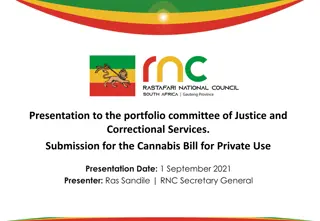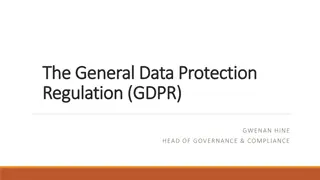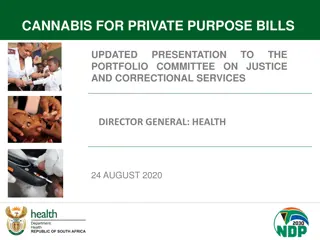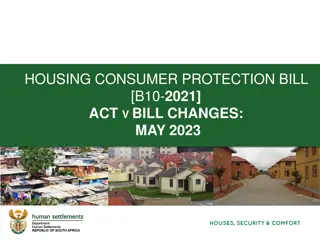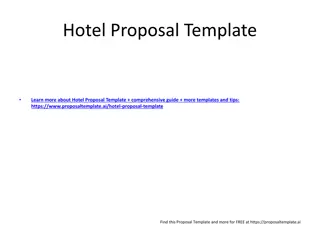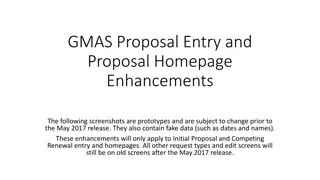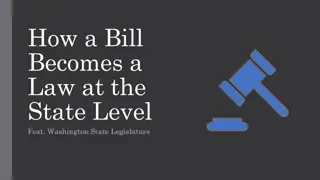Bill Protection Proposal Overview
The Bill Protection Proposal aims to support customers during a pilot program by ensuring those receiving appliances are not disconnected, offering joint IOU proposals, encouraging enrollment in discount programs, and providing bill credits over three years. Data elements, savings analysis, and framework results are outlined to address electric and non-electric bill impacts, with a focus on propane costs and savings for low-income customers. The proposal seeks to keep assumptions simple and consistent for effective implementation and evaluate options for increased customer support. Open questions are also highlighted for further consideration.
Download Presentation

Please find below an Image/Link to download the presentation.
The content on the website is provided AS IS for your information and personal use only. It may not be sold, licensed, or shared on other websites without obtaining consent from the author.If you encounter any issues during the download, it is possible that the publisher has removed the file from their server.
You are allowed to download the files provided on this website for personal or commercial use, subject to the condition that they are used lawfully. All files are the property of their respective owners.
The content on the website is provided AS IS for your information and personal use only. It may not be sold, licensed, or shared on other websites without obtaining consent from the author.
E N D
Presentation Transcript
Agenda 1. Elements of Proposal 2. Initial Joint IOU Proposal 3. Key Data Elements 4. Framework & Results 5. Savings vs. Increase 6. Non-CARE customer analysis 7. Operationalization 8. Open Questions 2
Elements of Proposal 1. Customers receiving appliances will not be disconnected during the pilot time period 2. Customers in arrears can participate in the pilot IOUs will leverage existing programs to get customers in good standing before the pilot begins 3. Customers must at least receive the electric heat pump water heater, and electric heat pump heating and cooling 4. Customers will be encouraged to enroll in any discount programs for which they are eligible 5. Initial Bill Protection results will be included with each quarterly energy cost impact report 6. Proposed Approach may be revisited during pilot 3
Initial Joint IOU Proposal Provide flat bill credit over three years to customers that sign up as follows Bill Protection Pilot Year 1: $288 Year 2: $140 Year 3: $72 Total: $500/3 years *Assuming no course correction 4
Key Data Elements Pre Electrification Data Post Electrification Data [Post Electric Bills] [Pre Electric Bills] Electric Bill Increase Electric Pre Customer Electric bills Post Customer Electric bills Non electric (propane, wood) Propane/wood bills Propane/wood bills [Pre Non-Electric Bills] [Post Non-Electric Bills] Non-Electric Bill Savings Energy Cost Impact = Non-Electric Bill Savings Electric Bill Increase 5
Joint IOU Framework & Results: Propane Costs Non-Electric Bill Savings $1,350? $500 $?? Low-Income Customers Goal: Keep propane assumptions simple & consistent initially 1. Modeled an extreme curtailer who uses no propane for heat to estimate the lowest non-electric bill savings based on 2009 RASS gas usage for single family home 1. Annual tank rental fee: $80 2. Annual cooking usage: 39 gallons @ $3/gallon = $118/yr 3. Annual hot water usage: 213 gallons @ $3/gallon = $638/yr 4. Total propane cost for extreme curtailer: $835 2. Propane rate of $3/gallon is below expected rate 1. Customer and available data indicates rates more like $3.50 3. Conservative assumption of lowest annual propane cost savings of $500/yr 6
Joint IOU Framework: Post-Electrification Electric Costs 1. Gathered customer-level usage and bill data from all customers in PG&E & SCE communities who had a complete 2017 and 2018 history 2. Applied the following incremental usage to past usage PG&E adjusted these incremental usages and applied them to 2018 usage Heat Pump Space Conditioning Heat Pump Electric Dryer 3. Re-calculated bills with incremental usage and the following rate changes 1. All-electric baseline E1 rate with high user surcharge 2. 20% DAC-GT/CS bill discount on top of CARE discount 4. Calculated the difference between pre & post install electric bills and total non- electric energy costs 7
Results: Post-Electrification Electric Costs Electric Bill Increase $378 -$39 $516 CARE Customers Analysis: 1. Gathered customer-level usage and bill data from all CARE-enrolled customers in 8 PG&E communities who had a complete 2017 and 2018 history (n=479) 2. Applied the following incremental usage to 2018 usage 1. Heat Pump Space Conditioning: 3500 kWh/yr (change from prior analysis) 2. Heat Pump Water Heat: 1004 kWh/yr 3. Electric Range: 310 kWh/yr 4. Heat Pump Electric Dryer: 150 kWh/yr (change from prior analysis) 3. Re-calculated 2018 bills with incremental usage and the following rate changes 1. All-electric baseline E1 rate with high user surcharge 2. 20% DAC-GT/CS bill discount on top of CARE discount 4. Calculate the difference between electric bills before and after 8
Savings vs. Increase Pre Electrification Data Post Electrification Data Electric Pre Customer Electric bills Post Customer Electric bills ($516 increase) Non electric (propane, wood) Propane/wood bills ($500) Propane/wood bills (Informed Assumptions) Energy Cost Impact = Non-Electric Bill Savings Electric Bill Increase Most extreme energy cost impact = [$500] [$516] = $16 energy cost increase 9
Analysis Results Non-CARE Electric Bill Increase 98.6 % of Non-CARE customers estimated electric bill increase is below expected propane cost of $1,350. These customers would save even without DAC-GT credits or bill protection. $1,129 $1,350 $472 $2,135 There are extreme examples that must be identified and addressed prior to electrification. Bill protection will not help this customer. Non-CARE Customers Analysis: 1. Gathered customer-level usage and bill data from all Non-CARE customers in 8 PG&E communities who had a complete 2017 and 2018 history (n=206) 2. Applied the following incremental usage to 2018 usage 1. Heat Pump Space Conditioning: 3500 kWh/yr (change from prior analysis) 2. Heat Pump Water Heat: 1004 kWh/yr 3. Electric Range: 310 kWh/yr 4. Heat Pump Electric Dryer: 150 kWh/yr (change from prior analysis) 3. Re-calculated 2018 bills with incremental usage and the following rate changes 1. All-electric baseline E1 rate 2. NO 20% DAC-GT/CS bill discount 4. Calculate the difference between electric bills before and after 10
Bill Protection Operationalization Delivery Both PG&E & SCE are committed to providing an on bill credit Frequency Quarterly/Monthly credit is pending internal operational feasibility discussions Other PG&E is exploring leveraging other existing programs in conjunction with the Bill Protection credit 11
Open Questions For Discussion How to define Phase 1, 2, and 3? Items parties will protest Items parties will advocate for (ex. Increased budget) What does course correction look like? 12
Appendix: Example Bill Forecast: Median Non-CARE Your last 12 months After Electric Appliances [$1,870] [$3,007] $1,129 Increase Electric Total: $1,870 Total: $3,007 Non electric (propane, wood) [$1,350] [$0] $1,350 Savings Total: $1,350? Total: $0 Savings Summary: Yr 1 Energy Cost Impact = $1,350 $1,129 = $221 savings/yr + 288 Credit = $ 509 savings Yr 2 Energy Cost Impact = $1,350 $1,129 = $221 savings/yr + 144 Credit = $ 365 savings Yr 3 Energy Cost Impact = $1,350 $1,129 = $221 savings/yr + 72 Credit = $ 293 savings Yr 4 Energy Cost Impact = $1,350 $1,129 = $221 savings/yr + 0 Credit = $221 savings 13
Appendix: PG&E Validating Analytical Framework Electric Bill Increase $378 -$39 $516 CARE Customers 1. Median post electrification usage and bill appears high compared to actuals: 1. Median based on model is 12,606 kWh/yr and $3,007/yr 2. Median actual 2018 electric usage and bill for all-electric la Vina and Fairmead Customers is 10,030 kWh/yr and $1,717 2. Validation of incremental Heat Pump Space Heat usage: 3500 kWh/yr 1. 2009 RASS forecast CZ3 Heat Pump Heating (831) + Central AC (1,359 kWh)= 2,190 kWh/year 2. Space heating/cooling usage from LBNL Tool is 2,369 + 1,558 = 3,927kWh/yr 1. 1,500 SF house with attic insulation, air sealing and heat pump 3. These represent normal usage (i.e. no curtailment) 3. Assuming underlying 2018 usage doesn t change is conservative: 1. Many customers will stop using inefficient space heaters and a/c units 2. Other energy efficiency measures will be installed (e.g. lighting) 14
Appendix: Example Bill Forecast: Median CARE After Electric Appliances + discounts Your last 12 months [$1,021] [$1,398] $378 Increase Electric Total: $1,021 Total: $1,398 Non electric (propane, wood) [$1,350] [$0] $1,300 Savings Total: $1,300? Total: $0 Savings Summary: Yr 1 Energy Cost Impact = $1,300 $378 = $922 savings/yr + 288 Credit = $ 1,210 savings Yr 2 Energy Cost Impact = $1,300 $378 = $922 savings/yr + 144 Credit = $ 1,066 savings Yr 3 Energy Cost Impact = $1,300 $378 = $922 savings/yr + 72 Credit = $ 944 savings Yr 4 Energy Cost Impact = $1,300 $378 = $922 savings/yr + 0 Credit = $ 922 savings 15
Appendix: Validating Space Conditioning Usage 1. 5 communities are in central CZ 3, three are near CZ 7 border 2. CZ3 is cooling dominated: 2009 RASS forecast CZ3 Heat Pump Heating (831 kWh) + Central AC (1,359 kWh)= 2,190 kWh/year 3. CZ7 is heating dominated: 2009 RASS forecast CZ7 Heat Pump Heating (5,509 kWh) + Central AC (1,169 kWh)= 6,678 kWh/year 4. Split system heat pump efficiencies continue to improve: 2006-8 Air-source Heat Pump Energy Star Requirements: Current Energy Star Requirements: 16
PG&E Billing Alternatives Pay each monthly bill amount Receive flat monthly credit toward each payment 2 Pay each monthly bill Receive monthly credit sized to offset potential bill shocks 1 3 4 Pay Average with 3 adjustments Credit applied to mitigate step ups Unused credit rolls over Pay estimated new average Credit applied at 12 months to offset any balance Unused credit rolls over 17
Appendix: Analytical Framework Pre Electrification Data Post Electrification Data [Post Electric Bills] [Pre Electric Bills] Electric Bill Increase Electric Pre Customer Electric bills Post Customer Electric bills Non electric (propane, wood) Propane/wood bills Propane/wood bills [Pre Non-Electric Bills] [Post Non-Electric Bills] Non-Electric Bill Savings Energy Cost Impact = Non-Electric Bill Savings Electric Bill Increase PG&E Proposal: 1. Examine the worst case for CARE customers to determine risk of energy cost increase: highest expected Electric Bill Increase and the lowest expected Non- Electric Bill Savings 2. Based on potential energy cost increase determine a bill protection credit to ensure beneficial energy cost impact during pilot and enable transition to all- electric appliances 18
Appendix: SJV DAC Pilots Decision Guidance The IOU bill protection workshop proposals and the IOU s Bill Protection and Affordability advice letters: Should incorporate monthly bill protection, and, as appropriate, annual true-up, mechanisms and must aim to avoid any monthly bill shock for participants; Should consider all pre- and post- pilot implementation energy costs (propane, wood, as feasible; and, as appropriate, natural gas and electricity costs); May consider a higher baseline allowance and/or a waiver of the Super User Electric Surcharge; Must be standardized across PG&E and SCE, who must collaborate and propose the same approach and present this in nearly identical advice letters; Will not require presentation of individual customer propane and/or wood bills as an eligibility criteria, but rather will be based on modeled customer costs and generalized assumptions, which may be reviewed and updated periodically to adjust the approach, as needed; Will be offered for an initial period of three years to each household receiving appliance upgrades, with a cost of $500 per householdas astarting point; and Will consider likely rebound effects and comfort needs, particularly amongst the poorest households that may have severely curtailed propane usage for water and/or space heating due to high costs. 19
